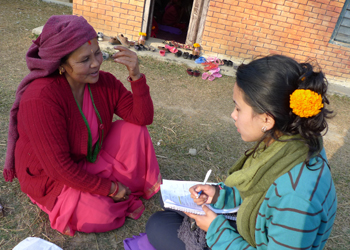 Story by Alina Karki | Planning, Monitoring and Evaluation Temp | Heifer Nepal
Story by Alina Karki | Planning, Monitoring and Evaluation Temp | Heifer Nepal
Photo courtesy of Heifer Nepal Staff
Followed by someone playing madal, a Nepalese drum, women clad in bright red saris and holding garlands, sang, danced and put tika, a red powder, on our foreheads. We certainly did not expect such a generous welcome. Ayumi and I started our journey with a road map of two districts?Nuwakot and Dhadhing and a questionnaire from which we planned to interview a few groups of women. However, what we received?a welcome into their homes, a stomach full of delicious food and their amazing stories?was so much more.
Ayumi is a graduate student at Brandeis University's Heller School. For the past four months, he has interned for Heifer Nepal. When he needed a translator for his assignment to conduct a "Social Capital, Income and Food Security" survey with 13 groups, I was happy to oblige. I had wanted to visit these women project participants for quite awhile.
During this process, we met 65 women, ranging in age from 19-60, in seven different villages. Each met with us individually for her interview. They were as excited as we were. I felt a bit hesitant, at first, because we were asking the farmers to take time away from their work to answer our questions, but they didn't seem to mind. I found that the women all shared a strong sense of belonging toward their group. Their responses often drifted from answering the questions asked to sharing their own stories. Common hardships we heard included the tragedy of being deserted by a husband, ill treatment from in-laws, poverty and lack of opportunity for education.
These women have found solace in their group?a place to share and be heard. The physical inputs and trainings provided by Heifer served as a small nudge that helped them become self-reliant and eventually take their own initiative toward building better lives for themselves. Now through group savings, they have created a pool of funds from which they can take out credit at affordable rates, make investments, and start community development projects and small businesses.
Each group member saves a small amount of money to contribute to the group savings. They use the money to construct roads, build bridges and make donations to schools. Most of these women had no access to credit five years ago. Now they can borrow money for their group at cheaper rates than local lenders, banks and finance companies offer. The women who were once limited to doing household chores and being free labor on their own farms are now entrepreneurs who sell milk, buffalo, cows, staple crops and cash crops, such as ginger, turmeric and goats. Some have opened their own shops, raise poultry and trade vegetables in the city. Now, in an ambitious step, the groups are planning to open their own cooperative, which will make credit available to all the villagers.
Men from the community were very helpful to the women, as well as to us, as visitors. The women told us that the men's helpful attitude is a dramatic shift from just a few years ago. Several women from Jurethum, a Tamang community, recalled that their husbands used to spend the day drinking alcohol and gambling, but now they are responsible and eager to help around the house.
There have been many changes over the three or four years that this community has been working with Heifer. I am excited to visit more communities and witness how Heifer's development model has helped them build better futures.